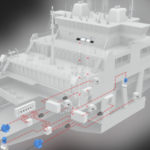In this second part of EEWorld’s “virtual roundtable” discussion on fuel cells, our panelists delve into the impact of the emergence of fuel cells on energy storage compared with conventional rechargeable batteries: What factors determine when fuel cells are more cost-effective than rechargeable batteries? How do the maintenance and monitoring needs of fuel cells compare with the needs of rechargeable batteries? And what are the barriers to using fuel cells in transportation applications such as electric vehicles, electric trains, or electric ships? Joining us for this virtual roundtable are Rami Reshef (RR), CEO and founder of GenCell Energy, and Andy Marsh (AM), CEO with Plug Power.
JS: What are the main challenges users face when first developing fuel cell applications or installations?

AM: Plug Power has made adoption simple by working directly with customers to understand the real and frequently immediate ROI benefits of making the switch from batteries to fuel cells. Once a company decides to adopt hydrogen and fuel cells, Plug Power can offer a comprehensive turnkey product, GenKey, that makes the installation simple from start to finish, including fueling, power, and aftermarket service.
RR: Developing fuel cells has had a very high barrier to entry, both in terms of the scientific knowledge and capital required. Historically fuel cell knowledge was limited to elite Space programs and academic and scientific research institutions. Significant scientific and engineering know-how is required to bring a commercial fuel cell to market, and the costs for production as well as for fuel cell materials and components are steep, raising the threshold for fuel cell manufacturers. Moreover, the requirements to adapt the fuel cell to the specific requirements for each different power application are not negligible. With wider recognition of the impact of global warming, renewed interest in alternative energy sources has brought a renaissance to the fuel cell segment and a huge expansion of governmental, industrial, and academic initiatives and budgets that is slowly overcoming these challenges.
Nevertheless, compared to combustion engines or batteries, there are still relatively far fewer fuel cell applications and installations. The margin of error in new projects is still significant, and because the public magnifying glass is focused directly on these implementations, every drawback is given wide coverage. The investments required in each technology are great, and the stakes are high.
As we indicated earlier, unlike the way the media portrays it, we don’t see this as a zero-sum game. On the contrary, battery and fuel cell technologies are complementary, and we believe that cooperation and collaboration can yield optimal power solutions.
JS: What is the critical use-case factor or factors determining when fuel cells are the most cost-effective choice?
GenCell G5 long-duration UPS provides a potentially unlimited source of 5kW backup power – along with support for peak loads of up to 100kVA
RR: Alkaline fuel cells are especially relevant for mission-critical applications where resilience and reliability are essential. Fuel cells are the best choice for applications where uninterrupted power is essential, and the damages caused by power loss are high, for example, to back up sophisticated medical devices used for life-saving surgery, to ensure sufficient refrigeration of expensive medicines with short expiration dates and for surveillance of long borders to prevent criminal or military incursions.
Because GenCell’s alkaline fuel cells are extremely durable and weather-resistant as well as seismic-compliant when deployed with protective enclosures and require infrequent servicing or maintenance, they are preferable for power applications in remote locations, difficult terrain, and tough climate conditions such as high altitude, high humidity, and sub-zero temperature zones.

By installing multiple fuel cells in a microgrid configuration, we achieve high internal redundancy between fuel cell stacks and make the entire application failsafe. For data centers, first-responders, and other scenarios where uninterrupted power is essential, fuel cells are extremely cost-effective.
Moreover, with the huge changes in the energy sector incorporating higher ratios of intermittent renewable energy resources and more distributed energy sites that can be alternately connected to or independent of the grid, volatility and fluctuation in power is greater, and stability is threatened. Incorporating fuel cells into this hybrid energy mix, whether at utilities as a backup for substation breakers or behind the meter for commercial and industrial businesses in need of high power reliability against the risk of outages or load shedding or that seek to save on energy costs during peak usage times can offer substantial value.
AM: Asset Utilization: High-asset utilization applications like material handling trucks, automated guided vehicles, or any on-road fleet vehicles that demand the vehicle to be in service work benefit from the extended use case operators see from their fuel cell-powered fleet.
Range: A battery EV could have a range of 250 miles at the expense of consuming 400 litres of space for battery and 30% of the payload, whereas fuel cells can achieve 300 miles range at the expense of consuming only 100 litres of space and less than 5% of the payload. Fuel cells allow vehicles to run longer – it’s that simple. As long as hydrogen fuel is in the tank, the vehicle will operate at full, continuous power. This is important for delivery vehicle applications. FedEx, for example, has seen a 166% increase in miles per delivery cycle over standard battery power alone. As the range needs to increase, and the payload increases for a delivery truck, the wells to wheel efficiency for a fuel cell start to outmatch the battery solution. For DHL, in light-duty vehicles for more than 125 miles, the battery electric vehicle just can’t do the job. The amount of batteries needed reduces the payload to nonoperative levels.
JS: How do the monitoring and maintenance requirements of fuel cells compare with the needs of rechargeable batteries?
AM: Plug Power uses intelligent data to ensure fuel cell uptime. Through the industrial internet of things (IoT), Plug Power is able to monitor from sites around the world. This allows the Plug Power team to provide predictive maintenance and immediate support in the case of a stalled piece of equipment. Unlike batteries, fuel cells do not degrade over time with each use and charge.
RR: Having few moving parts, fuel cells have no vibrations, and consequently, they are exceptionally quiet and suffer minimal wear and tear; as a result, they require minimal maintenance or servicing. In particular, stationary fuel cells need very little maintenance, with servicing required as little as once per year. While the membranes of PEM fuel cells are sensitive and must be properly maintained for optimal fuel cell performance, alkaline fuel cells are highly durable and, even after being placed in extended standby mode, will reliably kick-in and initiate the operation.
In contrast, although battery cell technology is improving, maintenance is still one of the biggest challenges for rechargeable battery applications and end-users. In order to maximize a battery’s performance over a long period, users need to carefully regulate the environment and conditions in which the battery is operated. The battery must be correctly stored, its capacity level must be carefully monitored, and best practices recommend using a battery management system to prevent overcharging that will reduce the battery’s lifetime.
GenCell delivers integrated monitoring software with its fuel cells to enable users to track equipment performance of units installed in remote locations. This IoT Remote Manager software offers rich functionality to monitor and control fuel cell performance in specific scenarios. For example, when backing up a power utility substation, the software can execute optimal monitoring and protection of the recloser equipment, recording past trip alarm, and control events. Full visibility into and control of the fuel cell as well as of field power quality analyzers and controllers enables optimal quality diagnostics and preventative maintenance, reducing downtime and improving efficiency. By configuring real-time alarms using cellular units with GPS functionality that activate upon any theft attempt, the software can prevent break-ins to remote equipment. The platform can be configured for remote meter readings, recording values, alarms, and control events to enable the end-user to understand trends and make real-time adjustments to optimize performance.
JS: What are the challenges to be overcome if fuel cells are to be used in applications such as electric vehicles, electric trains, or electric ships?
RR: The main challenges preventing mainstream adoption of fuel cells in the transportation sector center on unit cost and issues with fueling, both around hydrogen production, transport and storage, and the requirement for fuel purity. Regarding price – cost has long been and remains the key obstacle in the race between fuel cell electric vehicles – FCEVs and battery BEVs. While battery-electric vehicles have a head start over fuel cell vehicles, the growing demand to transition away from fossil fuels will have an impact on the FCEV economy of scale, and the prices of fuel cell vehicles will then come down.
The other key challenge to FCEVs is the fueling infrastructure – the huge investment needed to produce, transport, and store hydrogen to enable fueling of FCEVs is a huge constraint limiting the progress of fuel cells for cars. However, while battery technologies seem to be sufficient for small vehicles, this is not the case for heavy transport; batteries cannot power long-distance hauls without requiring extensive charging. Here fuel cell technologies have a clear advantage, and combining them with batteries will reduce the carbon footprint of the heavy-duty transport sector without compromising performance. The growth of fuel cell buses and trucks will somewhat expand the hydrogen fueling infrastructure, which could drive the growth of smaller FCEV cars.
Load and range have limited the success of efforts to decarbonize the rail industry with rechargeable battery technology. Fuel cells are better suited to drive trains that are expected to travel long distances at high speeds. However, powering heavy freight trains with hydrogen is challenging. And as with buses and trucks, there are still challenges around funding the high-cost of the hydrogen production and refueling infrastructure needed to support a fuel cell rail network. Regarding ocean vessels, while environmental issues are driving fuel cell adoption, technical and economic considerations such as fuel and infrastructure, volumetric size, ships integration issues, lifetime, high initial cost and operational cost-effectiveness as well as regulations and legislation all pose substantial challenges to the advent of fuel cell-powered marine shipping.
So, the key to unlocking the potential of fuel cells for transportation is the enormous investment required to build out a hydrogen infrastructure, an investment that competes with the existing fossil fueling infrastructure. Here we approach this formidable challenge with our ammonia cracker technology, which can extract hydrogen on demand wherever it is needed. We will soon be launching a solution that leverages this technology to offer off-grid power in remote locations. Looking ahead, we plan to scale this technology to enable large vehicles running on alkaline fuel cells that extract economical industrial-grade hydrogen from ammonia at existing fueling stations, avoiding the enormous investment required for new hydrogen fueling stations. And further ahead, we look to manufacture green ammonia from renewable energy for full decarbonization of the energy cycle. In the long run, green hydrogen and green ammonia powering fuel cells will allow the world to utilize renewable energy on a large scale to accelerate the vital transition to sustainable power.
AM: Fuel cell technology is robust and has a proven value proposition with electric fleet vehicles today. Through these deployments, we have essentially built a hydrogen highway across the United States, from Maine to California. Advancement in green hydrogen fuel is important for two reasons: sustainability and electrification. Expansion applications like electric vehicles, electric trains, or electric ships will benefit from critical advantages in the flexibility for the growth of the hydrogen infrastructure compared to the electrical infrastructure.
JS: Thanks to our panelists for sharing their insights and experience! You might also be interested in reading “Fuel cells capabilities and performance” – Virtual Roundtable (part 1 of 2).








Leave a Reply